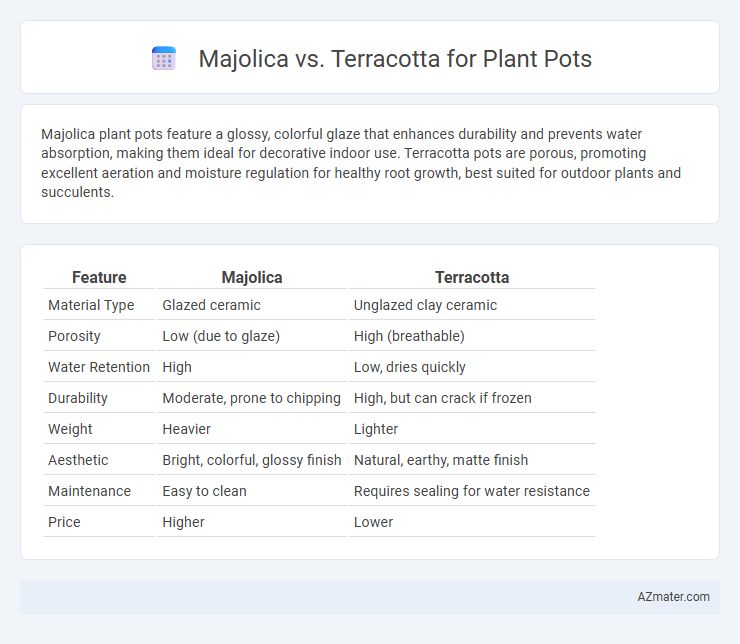Majolica plant pots feature a glossy, colorful glaze that enhances durability and prevents water absorption, making them ideal for decorative indoor use. Terracotta pots are porous, promoting excellent aeration and moisture regulation for healthy root growth, best suited for outdoor plants and succulents.
Table of Comparison
| Feature | Majolica | Terracotta |
|---|---|---|
| Material Type | Glazed ceramic | Unglazed clay ceramic |
| Porosity | Low (due to glaze) | High (breathable) |
| Water Retention | High | Low, dries quickly |
| Durability | Moderate, prone to chipping | High, but can crack if frozen |
| Weight | Heavier | Lighter |
| Aesthetic | Bright, colorful, glossy finish | Natural, earthy, matte finish |
| Maintenance | Easy to clean | Requires sealing for water resistance |
| Price | Higher | Lower |
Introduction to Majolica and Terracotta Plant Pots
Majolica plant pots feature a vibrant, glazed ceramic finish that enhances moisture retention and offers decorative appeal, making them ideal for indoor plants or shaded outdoor areas. Terracotta pots, crafted from natural clay, provide excellent breathability and drainage due to their porous structure, promoting healthy root growth especially in outdoor environments. Both materials offer distinct benefits: Majolica's colorful glazing resists water absorption, while terracotta's earthy texture supports aeration and temperature regulation for plants.
Material Composition: Majolica vs Terracotta
Majolica plant pots are crafted from earthenware clay coated with a tin-based glaze, resulting in a vibrant, glossy finish that enhances durability and water resistance. Terracotta pots are made from porous, unglazed clay that allows air and moisture to pass through, promoting healthy root aeration but requiring more frequent watering. The material composition of Majolica offers better moisture retention and decorative appeal, while Terracotta provides natural breathability and a rustic, earthy aesthetic.
Aesthetic Appeal: Colors & Designs
Majolica plant pots offer vibrant, glossy finishes with intricate hand-painted designs that create a striking visual impact, ideal for adding color and artistic flair to garden spaces. Terracotta pots feature a natural, earthy tone and rustic texture that provides a timeless, understated aesthetic, blending seamlessly with various plant types and outdoor environments. The choice between Majolica's colorful, decorative appeal and Terracotta's warm, organic look depends on whether the goal is to highlight ornamental artistry or achieve a classic, natural garden style.
Porosity and Drainage Comparison
Majolica plant pots feature a glazed surface that significantly reduces porosity, resulting in limited water absorption and slower drainage, which can retain moisture longer but risks root rot if overwatered. Terracotta pots, made from unglazed clay, exhibit high porosity that allows excess water to evaporate quickly, promoting aeration around plant roots and reducing the chance of waterlogging. This contrast in porosity and drainage makes terracotta ideal for plants requiring well-drained soil, while majolica suits moisture-loving species needing consistent hydration.
Durability and Longevity
Majolica pots, typically glazed with a colorful finish, offer enhanced durability against moisture and weather changes compared to porous terracotta pots, which can crack or erode over time due to their unglazed nature. The glaze on Majolica provides a protective barrier, reducing water absorption and extending the pot's longevity, making it ideal for both indoor and outdoor use. In contrast, terracotta pots require more careful handling and periodic sealing to maintain their structural integrity over multiple growing seasons.
Suitability for Indoor vs Outdoor Use
Majolica plant pots, with their glazed, water-resistant surfaces, are ideal for both indoor use and sheltered outdoor areas, offering vibrant colors and easy maintenance. Terracotta pots, being porous and breathable, excel in outdoor settings where they provide better aeration for plant roots but require more care indoors to prevent moisture damage. Choosing between Majolica and Terracotta depends on the specific environment and plant needs, balancing aesthetics and durability against exposure to weather conditions.
Weight and Handling Differences
Majolica pots are generally heavier due to their dense, glazed ceramic composition, offering robust durability but requiring more effort for handling and relocation. Terracotta pots are lighter, made from porous clay that is easier to move and reposition, making them ideal for gardeners who frequently rearrange plants. The weight difference significantly influences usability, with terracotta favored for portability and majolica for stability in outdoor setups.
Impact on Plant Health and Growth
Majolica pots, glazed and non-porous, retain moisture longer, reducing the frequency of watering and promoting consistent soil hydration essential for healthy root development. Terracotta pots, made from porous clay, allow air and moisture to pass through, enhancing oxygen availability to roots but increasing water evaporation, which may require more frequent watering to prevent plant stress. The choice between Majolica and Terracotta significantly impacts plant health by balancing moisture retention and aeration according to the specific needs of different plant species.
Maintenance and Cleaning Requirements
Majolica plant pots require gentle cleaning with mild soap and water to preserve their colorful glaze and prevent chipping, while avoiding harsh abrasives. Terracotta pots are porous, necessitating thorough drying between uses to prevent mold and using a vinegar soak to remove mineral buildup effectively. Both materials benefit from regular maintenance but terracotta demands more frequent cleaning due to its absorbent nature.
Cost and Value Considerations
Majolica plant pots typically have a higher initial cost due to their intricate glazing and decorative appeal, offering greater aesthetic value and durability compared to terracotta. Terracotta pots are more affordable and provide excellent breathability for plants, making them a cost-effective choice for gardeners prioritizing functionality over design. Considering long-term value, majolica pots may justify their higher price with enhanced weather resistance and visual appeal, while terracotta's porosity may require more frequent replacement in harsh climates.

Infographic: Majolica vs Terracotta for Plant Pot
 azmater.com
azmater.com